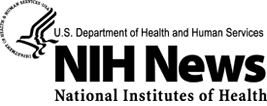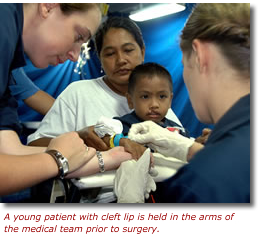Last updated: May 11, 2012
Scientists Identify Gene Variant Involved in Isolated Cleft Lip

National Human Genome Research Institute
www.genome.gov
National Institute of Dental and Craniofacial Research
www.nidcr.nih.gov
Scientists Identify Gene Variant Involved in Isolated Cleft Lip
 Bethesda, Md., Sun., Oct. 5, 2008 — About 20 percent of isolated cleft lip, one of the world's most common birth defects, may be due to a one-letter difference in the DNA sequence of a gene involved in facial development, researchers supported by the National Institutes of Health report.
Bethesda, Md., Sun., Oct. 5, 2008 — About 20 percent of isolated cleft lip, one of the world's most common birth defects, may be due to a one-letter difference in the DNA sequence of a gene involved in facial development, researchers supported by the National Institutes of Health report.
The scientists say the discovery, published online today in the journal Nature Genetics, could lead to DNA tests to help couples better gauge their risk of having a child with an isolated cleft lip. They also note that the gene variation provides a valuable clue to the complex developmental puzzle of cleft lip. Coupled with other recent gene discoveries and alterations, the scientists say they now can account for about 30 percent of isolated cleft lip. A generation ago, they had yet to identify a single gene alteration.
"This finding will improve our ability to explore the causes of cleft lip, develop better ways of treating clefts, and provide information on whether they might occur again in a family," said the paper's senior author Jeff Murray, M.D., a scientist at the University of Iowa and a grantee of NIH's National Institute of Dental and Craniofacial Research. "We hope that better prevention strategies can also be an outcome of this work, as it has already been shown that women who smoke during pregnancy can predispose their babies to develop a cleft."
About one in every 600 babies in the United States is born with isolated cleft lip and/or palate (roof of the mouth). Though the condition usually is correctable with several surgeries, families undergo tremendous emotional and economic hardship during the process, and children often require many other services, including complex dental care and speech therapy.
Doctors have long hoped for ways to prevent or reverse the problem before a baby is born and must undergo corrective surgery. But solutions have turned out to be hard to find. Isolated clefts arise during fetal development from disruptions in the dynamic but still poorly understood interplay of genes, diet, and environment.
One avenue to begin cutting through the complexity has been to isolate genes involved in the developmental process, which also serves as the starting point for the discovery published online today. Six years ago, Murray and colleagues hit the jackpot when they found a gene called IRF-6 causes the rare Van der Woude syndrome (VWS). The discovery marked a potentially important lead because about 15 percent of people with VWS have malformations that are clinically indistinguishable from isolated cleft lip and/or palate, suggesting the gene might be involved in both types of clefting.
While studying the gene's structure, the scientists noticed a single sequence variant that they said might cause isolated clefts. Such variants, called single nucleotide polymorphisms, or SNPs, occur about every 1,000 bases in our DNA and in most cases are harmless.
The research team included a group led by Eric Green, M.D., Ph.D. of NIH's National Human Genome Research Institute, who discovered this particular SNP resided in a stretch of DNA that is almost identical in sequence across 12 different animals. This suggested that the sequence must have been preserved without variation during evolution, and the variant represented an unnecessary and potentially disruptive change. "The evolutionary sequence comparisons across species pointed strongly to this error in the gene," said Green.
As reported today in Nature Genetics, Murray and colleagues provide more details on this mysterious SNP. Named rs642961, it occurs in a previously unexplored enhancer region of the IRF-6 gene. An enhancer region is a short stretch of DNA that a protein called a transcription factor binds to and, like a key in a lock, allows a gene to be read and copied, key early steps in producing a protein.
Fedik Rahimov, Ph.D., the paper's lead author and a scientist at the University of Iowa, explained that the SNP is no more than the substitution of an adenine (A) nucleotide, or unit of DNA, into the enhancer region instead of the usual guanine (G) nucleotide.
"We then were able to take the next step and predict that the G to A shift would alter the binding site for a protein called AP-2a," said Rahimov. "Why was this important? Because AP-2a is known to be involved in craniofacial development and, when altered, causes a syndrome that involves clefts."
"It also suggested AP-2a and IRF-6 interact in the same developmental pathway to make a baby's face," Rahimov continued. "This helps to connect some of the developmental dots in the clefting process, and that's powerful information to when designing possible interventions to prevent a cleft."
But Rahimov and his colleagues still had to nail down their suspicion. Using several large international DNA databases of baby's born with clefts and their family members, they found the frequency of their candidate SNP was significantly higher in babies born with cleft lip only. Indeed, the "A" SNP was responsible for about 18 percent of those born with cleft lip only.
"One of the great challenges in biology right now is to define the communal crosstalk among dividing fetal cells that prompt them to branch, arch, and synchronize their self assembly into intricate, three-dimensional patterns as dissimilar as the muscle in a lip or a cranial bone," said Murray, who also receives support from NIH's National Institute of Environmental Health Sciences and National Center for Research Resources. "This work gives us a little more to hang our investigative hats on and will help us discover more genes in the developmental process, information that is critically important for continued progress in the field."
The work was supported by the NIH's National Institute of Dental and Craniofacial Research, National Human Genome Research Institute, National Cancer Institute, National Institute of Environmental Health Sciences, and the Clinical Science Ward Program, led by the National Center for Research Resources.
The National Institutes of Health (NIH) - The Nation's Medical Research Agency - includes 27 Institutes and Centers and is a component of the U.S. Department of Health and Human Services. It is the primary federal agency for conducting and supporting basic, clinical and translational medical research, and it investigates the causes, treatments, and cures for both common and rare diseases. For more information about NIH and its programs, visit www.nih.gov.
Contact
Robert Kuska
NIDCR
kuskar@mail.nih.gov
Ray MacDougall
NHGRI
macdougallr@mail.nih.gov